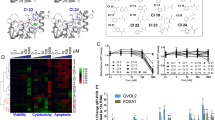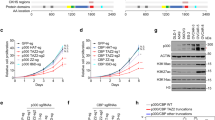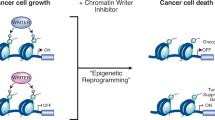Abstract
Histone acetylation has a central role in establishing an active chromatin environment. The functional contribution of histone acetylation to chromatin transcription is accomplished by a dominant action of histone acetyltransferases over repressive histone-modifying activities at gene promoters; misregulation of these dynamic events can lead to various diseases. Here, we describe the synthesis and characterization of transducible peptides derived from histone H4 N-terminal tail as a molecular tool to establish and maintain the active state of p53 target genes. Cellular experiments demonstrate a distinct increase in p53 transactivation by acetylated H4 tail peptides, but only a modest change by unmodified H4 tail peptides. The molecular basis underlying the observed effects involves the selective interaction of the tail peptides with G9a histone methyltransferase and histone deacetylase 1 (HDAC1) and the disruption of their occupancy at p53 target promoters. Furthermore, treatment of xenograft models and cancer cell lines with the tail peptides sharply decline tumor cell growth and enhances apoptosis in response to DNA damage. These results indicate that H4 tail peptide mimics upregulate p53 transcription pathway and may be used as a novel strategy for anticancer therapy.
This is a preview of subscription content, access via your institution
Access options
Subscribe to this journal
Receive 50 print issues and online access
$259.00 per year
only $5.18 per issue
Buy this article
- Purchase on Springer Link
- Instant access to full article PDF
Prices may be subject to local taxes which are calculated during checkout







Similar content being viewed by others
References
Harris SL, Levine AJ . The p53 pathway: positive and negative feedback loops. Oncogene 2005; 24: 2899–2908.
Kruse JP, Gu W . Modes of p53 regulation. Cell 2009; 137: 609–622.
Laptenko O, Prives C . Transcriptional regulation by p53: one protein, many possibilities. Cell Death Differ 2006; 13: 951–961.
Vousden KH, Lane DP . p53 in health and disease. Nat Rev Mol Cell Biol 2007; 8: 275–283.
An W, Kim J, Roeder RG . Ordered cooperative functions of PRMT1, p300, and CARM1 in transcriptional activation by p53. Cell 2004; 117: 735–748.
Barlev NA, Liu L, Chehab NH, Mansfield K, Harris KG, Halazonetis TD et al. Acetylation of p53 activates transcription through recruitment of coactivators/histone acetyltransferases. Mol Cell 2001; 8: 1243–1254.
Bochar DA, Wang L, Beniya H, Kinev A, Xue Y, Lane WS et al. BRCA1 is associated with a human SWI/SNF-related complex: linking chromatin remodeling to breast cancer. Cell 2000; 102: 257–265.
Espinosa JM, Emerson BM . Transcriptional regulation by p53 through intrinsic DNA/chromatin binding and site-directed cofactor recruitment. Mol Cell 2001; 8: 57–69.
Espinosa JM, Verdun RE, Emerson BM . p53 functions through stress- and promoter-specific recruitment of transcription initiation components before and after DNA damage. Mol Cell 2003; 12: 1015–1027.
Kim JK, Esteve PO, Jacobsen SE, Pradhan S . UHRF1 binds G9a and participates in p21 transcriptional regulation in mammalian cells. Nucleic Acids Res 2009; 37: 493–505.
Haberland M, Montgomery RL, Olson EN . The many roles of histone deacetylases in development and physiology: implications for disease and therapy. Nat Rev Genet 2009; 10: 32–42.
Miremadi A, Oestergaard MZ, Pharoah PD, Caldas C . Cancer genetics of epigenetic genes. Hum Mol Genet 2007; 16 (Spec No 1): R28–R49.
Muntea AG, Hess JL . Epigenetic dysregulation in cancer. Am J Pathol 2009; 175: 1353–1361.
Spannhoff A, Hauser AT, Heinke R, Sippl W, Jung M . The emerging therapeutic potential of histone methyltransferase and demethylase inhibitors. Chem Med Chem 2009; 4: 1568–1582.
Spotswood HT, Turner BM . An increasingly complex code. J Clin Invest 2002; 110: 577–582.
Stimson L, Wood V, Khan O, Fotheringham S, La Thangue NB . HDAC inhibitor-based therapies and haematological malignancy. Ann Oncol 2009; 20: 1293–1302.
Tan J, Yang X, Zhuang L, Jiang X, Chen W, Lee PL et al. Pharmacologic disruption of Polycomb-repressive complex 2-mediated gene repression selectively induces apoptosis in cancer cells. Genes Dev 2007; 21: 1050–1063.
Peterson CL, Laniel MA . Histones and histone modifications. Curr Biol 2004; 14: R546–R551.
Issaeva N, Friedler A, Bozko P, Wiman KG, Fersht AR, Selivanova G . Rescue of mutants of the tumor suppressor p53 in cancer cells by a designed peptide. Proc Natl Acad Sci USA 2003; 100: 13303–13307.
Joliot A, Prochiantz A . Transduction peptides: from technology to physiology. Nat Cell Biol 2004; 6: 189–196.
Moellering RE, Cornejo M, Davis TN, Del Bianco C, Aster JC, Blacklow SC et al. Direct inhibition of the NOTCH transcription factor complex. Nature 2009; 462: 182–188.
Polo JM, Dell’Os T, Ranuncolo SM, Cerchietti L, Beck D, Da Silva GF et al. Specific peptide interference reveals BCL6 transcriptional and oncogenic mechanisms in B-cell lymphoma cells. Nat Med 2004; 10: 1329–1335.
Snyder EL, Meade BR, Saenz CC, Dowdy SF . Treatment of terminal peritoneal carcinomatosis by a transducible p53-activating peptide. PLoS Biol 2004; 2: 186–193.
Frankel AD, Bredt DS, Pabo CO . Tat protein from human immunodeficiency virus forms a metal-linked dimer. Science 1988; 240: 70–73.
Wadia JS, Dowdy SF . Transmembrane delivery of protein and peptide drugs by TAT-mediated transduction in the treatment of cancer. Adv Drug Deliv Rev 2005; 57: 579–596.
Mosammaparast N, Guo Y, Shabanowitz J, Hunt DF, Pemberton LF . Pathways mediating the nuclear import of histones H3 and H4 in yeast. J Biol Chem 2002; 277: 862–868.
Moll UM, Wolff S, Speidel D, Deppert W . Transcription-independent pro-apoptotic functions of p53. Curr Opin Cell Biol 2005; 17: 631–636.
Nishiyama A, Mochizuki K, Mueller F, Karpova T, McNally JG, Ozato K . Intracellular delivery of acetyl-histone peptides inhibits native bromodomain-chromatin interactions and impairs mitotic progression. FEBS Lett 2008; 582: 1501–1507.
Souroujon MC, Mochly-Rosen D . Peptide modulators of protein-protein interactions in intracellular signaling. Nat Biotechnol 1998; 16: 919–924.
Walensky LD, Kung AL, Escher I, Malia TJ, Barbuto S, Wright RD et al. Activation of apoptosis in vivo by a hydrocarbon-stapled BH3 helix. Science 2004; 305: 1466–1470.
Harada Y, Kanehira M, Fujisawa Y, Takata R, Shuin T, Miki T et al. Cell-permeable peptide DEPDC1-ZNF224 interferes with transcriptional repression and oncogenicity in bladder cancer cells. Cancer Res 2010; 70: 5829–5839.
Huang J, Dorsey J, Chuikov S, Pérez-Burgos L, Zhang X, Jenuwein T et al. G9a and Glp methylate lysine 373 in the tumor suppressor p53. J Biol Chem 2010; 285: 9636–9641.
Heo K, Kim H, Choi SH, Kim K, Gu J, Lieber MR et al. FACT-mediated exchange of histone variant H2AX regulated by phosphorylation of H2AX and ADP-ribosylation of Spt16. Mol Cell 2008; 30: 86–97.
Acknowledgements
We thank Dr Michael Stallcup and Mr Dan Gerke for the gift of pSG5-FLAG-G9a and G9a shRNA constructs. The technical assistance of Drs Balachandra Hegde and Ralph Langen in circular dichroism analysis is greatly acknowledged. We also thank Dr Jing Huang for p53K373me2 antibody. This work was supported by R01GM84209 to WA from the National Institutes of Health, RSG DMC1005001 to WA from the American Cancer Society and DIRAMS (50595-2012) to KH from the Ministry of Education, Science and Technology.
Author information
Authors and Affiliations
Corresponding author
Ethics declarations
Competing interests
The authors declare no conflict of interest.
Additional information
Supplementary Information accompanies the paper on the Oncogene website
Supplementary information
Rights and permissions
About this article
Cite this article
Heo, K., Kim, JS., Kim, K. et al. Cell-penetrating H4 tail peptides potentiate p53-mediated transactivation via inhibition of G9a and HDAC1. Oncogene 32, 2510–2520 (2013). https://doi.org/10.1038/onc.2012.273
Received:
Revised:
Accepted:
Published:
Issue Date:
DOI: https://doi.org/10.1038/onc.2012.273
Keywords
This article is cited by
-
Inhibition of histone methyltransferase G9a attenuates liver cancer initiation by sensitizing DNA-damaged hepatocytes to p53-induced apoptosis
Cell Death & Disease (2021)
-
Gene dysregulation by histone variant H2A.Z in bladder cancer
Epigenetics & Chromatin (2013)



